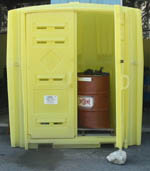 Why are hazardous materials use, storage, and disposal a stormwater issue?
Why are hazardous materials use, storage, and disposal a stormwater issue?
Hazardous materials, such as paints, cleaners, solvents, herbicides/pesticides, and other industrial chemicals can contaminate stormwater if used, stored, or disposed of improperly, or if spills or leaks are not cleaned up immediately.
This issue is addressed separately here from the environmental regulations for the storage and disposal of hazardous materials/waste that is discussed further in the Hazardous Waste web page.
Tenants are required to prevent or reduce pollutants exposed to or discharged to stormwater from the use, storage, and disposal of hazardous materials. However, there is flexibility in what measures tenants can implement to accomplish this. MAA has developed Stormwater Pollution Prevention Plans (SWPPPs) for both BWI Marshall and Martin State Airport permits. The plans identify best management practices for both MAA staff and tenants related to these activities.
Some examples of best management practices tenants can adopt for the storage of hazardous materials include:
- Placing containers in a designated area that is paved, free of cracks and gaps, and impervious in order to contain leaks and spills. The area should also be covered.
- Surrounding stored hazardous materials and waste with a curb or dike to contain spills. The spill containment area must be large enough to contain 10 percent of the volume of all of the containers or 110 percent of the volume of the largest container, whichever is greater. The area inside the curb should slope to a drain and a dead-end sump should be installed in the drain.
- Eliminating or reducing where possible the amount of hazardous materials and waste by substituting non-hazardous or less hazardous material.
- Using non-caustic detergents instead of caustic cleaning agents for parts cleaning.
- Using detergent-based or water-based cleaning systems in place of organic solvent degreasers. Wash water may require treatment before it can be discharged to the sewer.
- Replacing chlorinated organic solvents with non-chlorinated solvents. Non-chlorinated solvents like kerosene or mineral spirits are less toxic and less expensive to dispose of properly. Check list of active ingredients to see whether the cleaner contains chlorinated solvents.
- Choosing cleaning agents that can be recycled.
- Storing reactive, ignitable, or flammable liquids in compliance with the fire and hazardous waste codes.
- Preventing stormwater from entering the waste management area by enclosing the area or building a berm around the area
- Preventing the waste materials from directly contacting rain.
- Covering waste piles with temporary covering material such as reinforced tarpaulin, polyethylene, polyurethane, polypropylene, or hypalon.
- Covering the area with a permanent roof if feasible.
- Covering dumpsters to prevent rain from washing waste out of holes or cracks in the bottom of the dumpster.
- Moving the activity indoors after ensuring all safety concerns such as fire hazard and ventilation are addressed.
- Minimizing the storage of hazardous materials on-site.
- Conducting regular inspections of storage areas to assure there have been no spills or potential sources of stormwater contamination.
- Training employees and contractors to be familiar with these practices.
One of the requirements of tenant leases is that tenants must adhere to the requirements of the applicable tenant directives and associated regulations. Not adhering to these requirements can impact the standing of the tenant lease.
Additionally, many of the best management practices identified above are those included in the SWPPP, which is applicable to both the MAA and tenants at the airport. Not implementing best management practices in association with tenant activities may result in the contamination of stormwater at the airport. The MAA is legally obligated to report any illegal discharges to MDE who may issue fines or penalties for non-compliance with the Clean Water Act and the NPDES Permit. This may result in civil or criminal penalties (see Part II.C.15 and 16 of the stormwater permit for more detail).
There are a number of publications available that provide additional information on this topic including the following:
